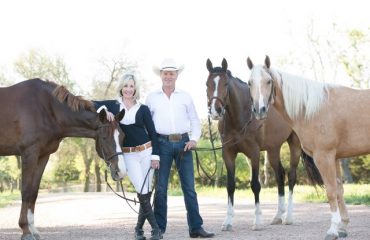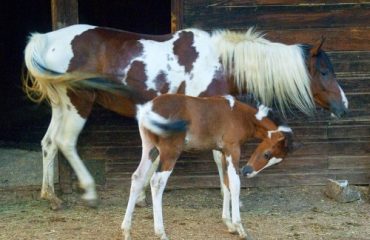
By Katie Navarra
Like many young girls, Elizabeth Letts devoured Marguerite Henry’s books. She enthusiastically read each one of the author’s classics from “King of the Wind” to “Misty of Chincoteague” and “Stormy: Misty’s Foal.” The books fueled her pursuit of riding activities and inspired a new interest: the goal of becoming an author.
“I always knew I’d be a writer. As a child, I remember thinking to myself that I wanted to write books like Marguerite Henry, but I worried that she would get to all the good stories before I grew up,” Elizabeth said.

Elizabeth started her riding career as a hunter-jumper but later became an eventer.
It wouldn’t be until the mid-2000s, after Elizabeth graduated from Yale University, where she majored in history and studied creative writing, that she’d learn Marguerite hadn’t gotten to all of the good stories. Elizabeth had published three novels that weren’t selling well and was at a crossroads in her writing career when she stumbled upon a black-and-white photo of an unbelievable horseback riding stunt.
The photograph memorialized show jumping champions Harry deLeyer and Snowman, clearing two oxers with a gray mare standing between the fences.
“That picture really spoke to me because as a kid I did all kinds of crazy stunts with my horse when no one was watching,” she said.
As a Pony Club rider, Elizabeth showed hunter-jumpers until she was 12, then she transitioned to eventing and went on to compete at the North American Junior Championship (now Young Riders) in Lexington, Kentucky, in 1977. Driven to learn more about the daredevil horseman and his mount, she started an internet search that yielded basic background information about Harry’s career and his rescue of the slaughter-bound Snowman.
“I’d grown up on the West Coast and had never heard of Snowman. When I started talking to other people I realized that they had a regional following,” she said.

“The Eighty-Dollar Champion”
The Eighty-Dollar Champion
Encouraged by the early research, she contacted Harry and discussed the potential of a book. Unsure of where, if anywhere, the opportunity would lead, they arranged to meet. Elizabeth quickly realized that the bond between Harry and Snowman was the real deal. “His bond with the horse was so genuine that he had tears in his eyes talking about it,” she said.
She started digging deeper, looking for newspaper clippings, show records and more that would help her tell the story. In 2011, three years after finding the photo, Random House published “The Eighty-Dollar Champion” which quickly became a New York Times Best-Seller.
Not only did the book reinvigorate Elizabeth’s writing career, it was the catalyst for her next writing project, “The Perfect Horse.”

Elizabeth and Harry deLeyer. Elizabeth’s book “The Eighty-Dollar Champion” is the story of Harry and his horse Snowman.
While conducting research for “The Eighty-Dollar Champion” at the National Sporting Library & Museum in Middleburg, Virginia, she happened across a 1946 booklet promoting a parade of Lipizzaner horses. The World War II-era document was shuffled amongst other newspaper clippings. It advertised the daring mission of U.S. armed forces that ultimately saved the purebred horses from becoming a casualty of war.
Notes about the horses’ magnificence were penciled in the margins and the brilliant white horses reminded her of her childhood idol, Marguerite Henry. Marguerite’s book, “White Stallions of Lippiza,” had always been one of Elizabeth’s favorites. “You can go looking for stories, but somehow the stories that you’re meant to write will find you,” she said.

“The Perfect Horse”
The Perfect Horse
The Lipizzaner story had to wait, but it was not forgotten. In 2012, Elizabeth revisited the idea and the plot for “The Perfect Horse” started to take form. The narrative she weaves retraces the plight of Europe’s finest horses. The horses, purebred Arabians and Lipizzaners, were not exempt from Germany’s eugenics experiments. The goal with the horses was to develop “the perfect military horse.”
Her research started at the National Sporting Library & Museum and soon rippled out to descendants of World War II veterans.
Her research connected her with relatives spanning both sides of the ocean, several countries and even opposing armies. Some families meticulously preserved photographs and firsthand accounts written by deceased family members. Others brought shoeboxes of curled photographs for her to inspect, asking if she could translate the images before her. She says she was lucky to be a part of a family’s discovery of a relative’s past.
“Someone would find pictures in the bottom of a relative’s trunk in the attic and say that they had inherited it, but didn’t know the story behind it,” she said.
She connected with the nephew of the manager from Hostau stud farm, one place that provided refuge for Europe’s finest horses, and joined him on a historical trip back to the now defunct farm.

Elizabeth meeting with children and grandchildren of Lieutenant Quinlivan, one of the characters in Elizabeth’s book “The Perfect Horse.”
“My greatest debt, without any doubt, is to the families of the veterans who so generously shared their photo albums, old letters, scrapbooks and personal memories,” she said.
“The Perfect Horse” was released in hardcover in 2016 at a time when scores of untold stories from World War II were appearing in print. This May, “The Perfect Horse” will also be available in paperback.
“History really does get lost. It seems like the events of World War II have been historicized to death, but that’s not true,” she said. “I found a fantastic audience in the horse industry and among the general readership. Readers have a big appetite for this type of story and I feel strongly that there is room at the table for more authors.”
Though she’s not sharing details about her next project, expect that it will be a fiction book. Fans can anticipate her next release sometime in 2019.













